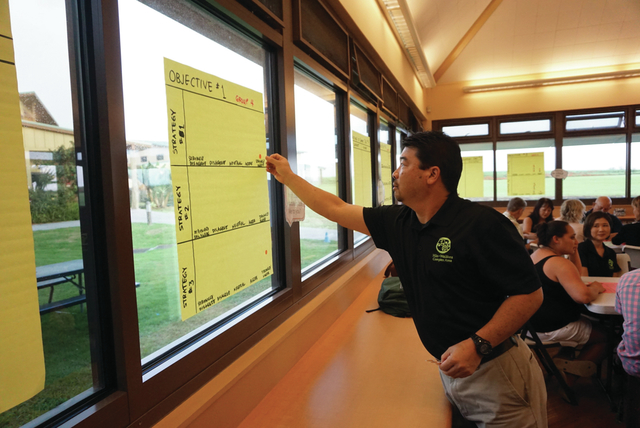WAIMEA — A community meeting Wednesday designed to gather feedback from the public about the state Department of Education and Board of Education’s strategic plan attracted roughly three dozen people from throughout the island, including teachers and administrators from the
WAIMEA — A community meeting Wednesday designed to gather feedback from the public about the state Department of Education and Board of Education’s strategic plan attracted roughly three dozen people from throughout the island, including teachers and administrators from the island’s public and charter schools.
It was the first Board of Education community meeting regarding the strategic plan and the only one to be held on the Big Island.
Officials hope to be able to present a final plan to the board in December.
The strategic plan is built on three main goals: student success, staff success and building “successful systems of support.”
At the meeting, Tammi Chun, assistant superintendent for the Office of Strategy, Innovation and Performance, told attendees that the current strategic plan has already shown positive results, including reduced chronic absenteeism, higher enrollment in advanced placement and early college classes as well as increased college enrollment.
But with the introduction of the Every Student Succeeds Act, the department and board is revisiting current strategies to be more in line with the new law.
That law, signed in December 2015, is replacing the previous No Child Left Behind Act. The new law is intended to give more flexibility to states in developing education goals and policies.
During Wednesday’s meeting, education officials asked community stakeholders for feedback on the specific objectives the department has identified for the state’s schools.
“This is an an evolving process,” said Tammi Chun, assistant superintendent for the Office of Strategy, Innovation and Performance. “Based on the feedback, we are making changes.”
During the meeting, Chun identified four specific objectives for the strategic plan. Those objectives included empowering students to achieve their goals, giving students a “rigorous, well-rounded education,” ensuring students are safe, healthy and empowered in schools and ensuring students successfully transition from grade to grade and school to school throughout their time in the school system.
Included with those objectives were a number of strategies intended to help schools meet those objectives.
During Wednesday’s meeting, audience members got an opportunity to give feedback on those objectives and strategies. Attendees were divided into groups, each tasked with focusing on one specific objective. They were also asked to indicate how strongly they agreed or disagreed with the proposed strategies.
Darrell Nekoba, school renewal specialist for the Hilo Waiakea Complex Area, said he agreed with the proposed strategies about ensuring students are empowered to achieve their goals for the future.
The department and board’s strategies to meet that objective included engaging in “learning that is relevant” and promoting career and college readiness.
Nekoba said teachers have a responsibility to bring “relevance and exposure” to their students.
That’s accomplished, he said, by creating partnerships with community members who can demonstrate education’s relevance beyond the classroom.
“It’s really helping them to see what their education is all about,” he said.
And that’s not only the hard skills that students learn in schools, but also soft skills like communication and team work.
Nekoba said he likes the way the objectives and strategies are shaping up.
“I like the evolution of them,” he said. “I see how we’re starting to look at relevance.”
Debbie Anderson, the librarian at Waiakea Intermediate School, said she wants the state to bring back the “senior project,” which required students to create and present a project based on a specific area of interest.
“I thought it was an incredible process,” she said.
The senior project, said Anderson, bridged the gap between leaving high school and entering college or a career. The project had students research an area of interest and then develop a portfolio and project, which would then be presented to a panel.
“Every student shows what they’re capable of,” she said.
Anderson suggested it be incorporated into the state’s strategy for providing students with a well-rounded education.
“This was the best thing I’ve ever seen for involving the community in our seniors’ lives,” she said.
Still, others left feedback strongly disagreeing with the department and board’s proposed approaches to reforming education in Hawaii.
One participant took issue with one proposed strategy to ensure students “explore, plan and prepare” so they graduate with knowledge and skills needed for post-secondary education.
The note, left on a board asking for feedback on the proposed objective, called the proposal “a weak statement.”
“However, this objective needs to focus on all training options like on-the-job training and (vocational education).”
While Wednesday’s meeting was the only one scheduled for the Big Island, two town hall meetings have been scheduled on the island for the public to learn more about the Every Student Succeeds Act.
The first will be Aug. 17 at Kealakehe High School from 4:30-6:30 p.m. The second will take place in Hilo at Waiakea High School on Aug. 24, also from 4:30-6:30 p.m.



